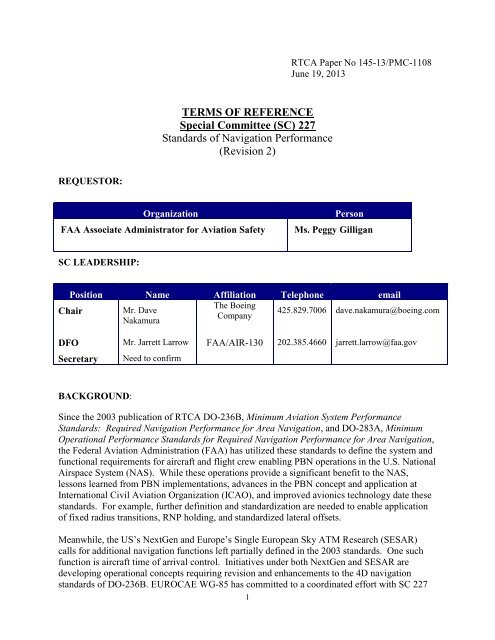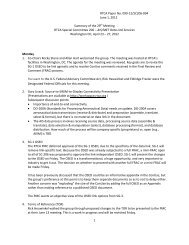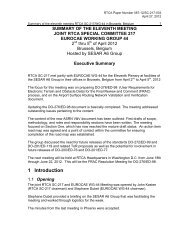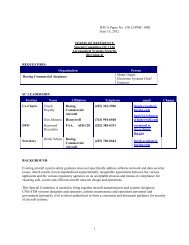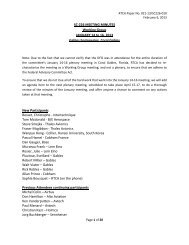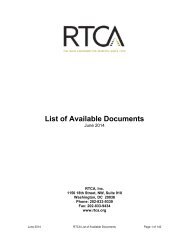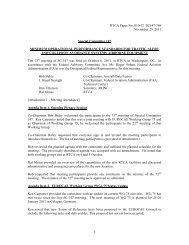June 19, 2013 - RTCA
June 19, 2013 - RTCA
June 19, 2013 - RTCA
Create successful ePaper yourself
Turn your PDF publications into a flip-book with our unique Google optimized e-Paper software.
<strong>RTCA</strong> Paper No 145-13/PMC-1108<br />
<strong>June</strong> <strong>19</strong>, <strong>2013</strong><br />
TERMS OF REFERENCE<br />
Special Committee (SC) 227<br />
Standards of Navigation Performance<br />
(Revision 2)<br />
REQUESTOR:<br />
Organization<br />
FAA Associate Administrator for Aviation Safety<br />
Person<br />
Ms. Peggy Gilligan<br />
SC LEADERSHIP:<br />
Position Name Affiliation Telephone email<br />
The Boeing<br />
Chair Mr. Dave<br />
425.829.7006 dave.nakamura@boeing.com<br />
Company<br />
Nakamura<br />
DFO Mr. Jarrett Larrow FAA/AIR-130 202.385.4660 jarrett.larrow@faa.gov<br />
Secretary<br />
Need to confirm<br />
BACKGROUND:<br />
Since the 2003 publication of <strong>RTCA</strong> DO-236B, Minimum Aviation System Performance<br />
Standards: Required Navigation Performance for Area Navigation, and DO-283A, Minimum<br />
Operational Performance Standards for Required Navigation Performance for Area Navigation,<br />
the Federal Aviation Administration (FAA) has utilized these standards to define the system and<br />
functional requirements for aircraft and flight crew enabling PBN operations in the U.S. National<br />
Airspace System (NAS). While these operations provide a significant benefit to the NAS,<br />
lessons learned from PBN implementations, advances in the PBN concept and application at<br />
International Civil Aviation Organization (ICAO), and improved avionics technology date these<br />
standards. For example, further definition and standardization are needed to enable application<br />
of fixed radius transitions, RNP holding, and standardized lateral offsets.<br />
Meanwhile, the US’s NextGen and Europe’s Single European Sky ATM Research (SESAR)<br />
calls for additional navigation functions left partially defined in the 2003 standards. One such<br />
function is aircraft time of arrival control. Initiatives under both NextGen and SESAR are<br />
developing operational concepts requiring revision and enhancements to the 4D navigation<br />
standards of DO-236B. EUROCAE WG-85 has committed to a coordinated effort with SC 227<br />
1
in the development of 4D standards in both <strong>RTCA</strong> DO-236 and EUROCAE ED-75 that will<br />
support application of trajectory-based airspace.<br />
DELIVERABLES:<br />
Product Description Due Date Change<br />
DO-236 – Minimum<br />
Aviation System<br />
Performance Standards:<br />
Required Navigation<br />
Performance for Area<br />
Navigation<br />
Change 1 to DO-236C<br />
This document will define the<br />
minimum aviation system<br />
performance standards for area<br />
navigation systems operating in an<br />
RNP environment.<br />
This change to the MASPS will<br />
define:<br />
1. The four dimensional (4D)<br />
standards that support both RNP<br />
and trajectory-based operations.<br />
2. A standard for wrong runway<br />
monitoring in support of aviation<br />
safety initiatives.<br />
<strong>June</strong> <strong>2013</strong><br />
December,<br />
2014*<br />
DO-283 - Minimum<br />
Operational Performance<br />
Standards: Required<br />
Navigation Performance for<br />
Area Navigation<br />
The document will define the 4<br />
dimensional minimum operational<br />
performance standards for<br />
navigation systems intended for<br />
application in a PBN environment.<br />
*Committee intends to make a best effort for earlier completion.<br />
March 2015*<br />
March<br />
<strong>2013</strong><br />
SCOPE:<br />
The special committee will develop navigation standards intended for designers, manufacturers,<br />
and installers of avionic equipment; airspace managers and service providers; and the users of<br />
these navigation systems for world-wide operations. The new MASPS will provide guidance for<br />
the development of airspace and operational concepts needed to obtain the benefits of enhanced<br />
navigation capability in the aircraft. The MOPS will provide the minimum set of requirements<br />
needed to demonstrate compliance with the performance and functions in the MASPS while<br />
enabling compliance with the PBN operations envisioned to support NextGen and SESAR. The<br />
MOPS will also be compatible with the upcoming ICAO navigation specification for advanced<br />
RNP, to be published in the update to the ICAO PBN Manual, Document 9613.<br />
ENVISIONED USE OF DELIVERABLE(S)<br />
FAA policy and guidance for PBN, to include aircraft qualification and certification criteria,<br />
along with operational approval guidance, will reference the updated MASPS.<br />
The updated MOPS will become the foundation for a new revision to TSO-C115.<br />
2
SPECIFIC GUIDANCE:<br />
The special committee will work collaboratively to meet the following Terms of Reference:<br />
<br />
<br />
<br />
<br />
<br />
<br />
<br />
<br />
Describe and revisit functions as necessary to ensure consistent navigation performance<br />
for newly considered operations. These operations should include, but not be limited to,<br />
RF legs, fixed radius transitions, RNP holding, lateral offsets, and time of arrival control.<br />
The special committee will develop accuracy requirements, error budgets, and required<br />
operational characteristics for each phase of flight, as applicable. The description will<br />
be in sufficient detail to ensure standardization of navigation functions at the aircraft<br />
level.<br />
Revisit, as appropriate, lessons learned from the operational implementations of PBN to<br />
develop further definition of the operational concepts embraced in the MASPS and<br />
MOPS. These concepts should include, but not be limited to, RF leg performance, fly-by<br />
fix turn performance, vertical navigation performance, and implementation and<br />
application of temperature compensation.<br />
Develop new criteria by considering existing reference material, including the ICAO<br />
PBN Manual, NextGen Advisory Committee Trajectory Operations task group products,<br />
EUROCAE ED-75B addendum supporting 4D navigation standards, operational safety<br />
enhancements, and changes to navigation sensor standards (e.g. GNSS, SBAS, and<br />
GBAS) since the 2003 publications. The goal is to identify duplicate and contradictory<br />
material and coordinate actions for standardization of requirements for international<br />
applications.<br />
Determine appropriate level of functionality for the MOPS in order to support the needs<br />
of industry and to enable NextGen. Define the consensus baseline performance standard.<br />
Coordinate with SC-214 to ensure consistent definition and use of navigation metrics to<br />
enable advanced data communications services.<br />
Coordinate with SC-186 to ensure proper requirement allocation, as needed, to support<br />
navigation system integration with ADS-B out and ADS-B in applications.<br />
Coordinate with SC-217, as needed, to ensure data standards and database processes<br />
consistent with MASPS and MOPS requirements.<br />
Coordinate with SC-159, as needed, to ensure MASPS RNP requirements provide<br />
greater clarity and guidance for GNSS navigators that will be developed for RNP<br />
applications.<br />
Initial Documentation - the following documents should be made available to this committee:<br />
Documents<br />
<strong>RTCA</strong> DO-236C<br />
<strong>RTCA</strong> DO-283A<br />
Intended Use<br />
Review and use as baseline<br />
Review and use as baseline<br />
TERMINATION: Activities of SC-227 will terminate with approval by the PMC of the<br />
committee’s final documents. Any change/extension of a committee’s terms of reference requires<br />
prior PMC approval.<br />
3


